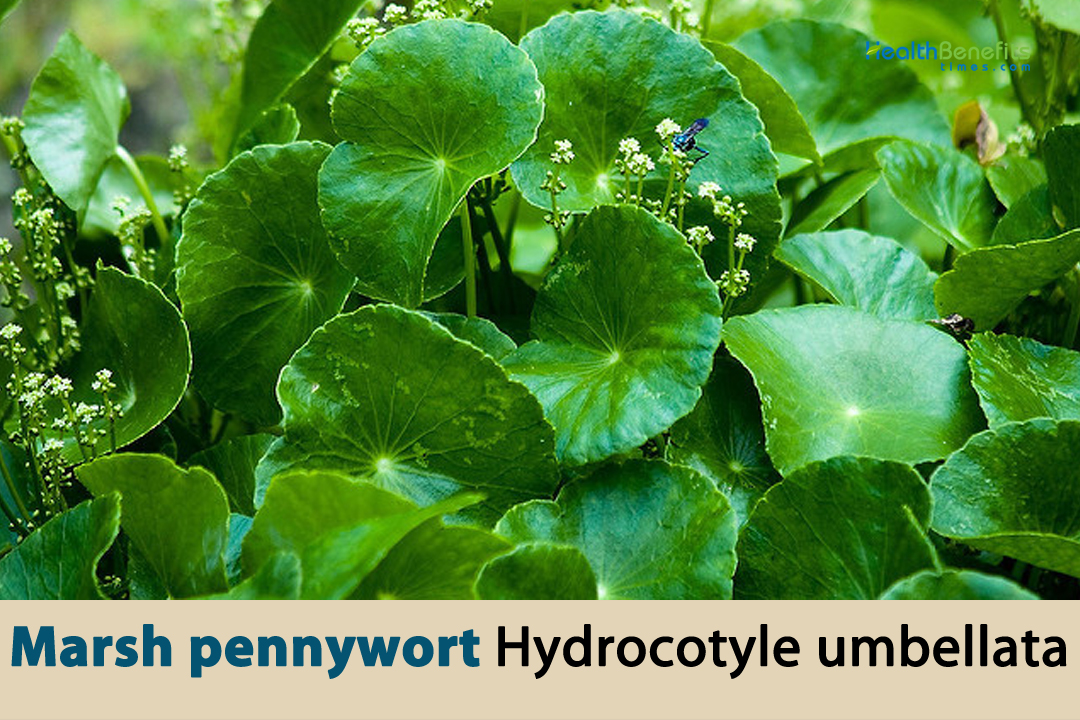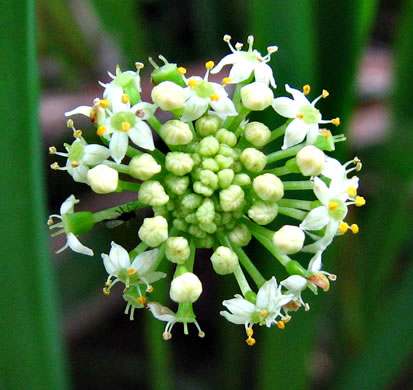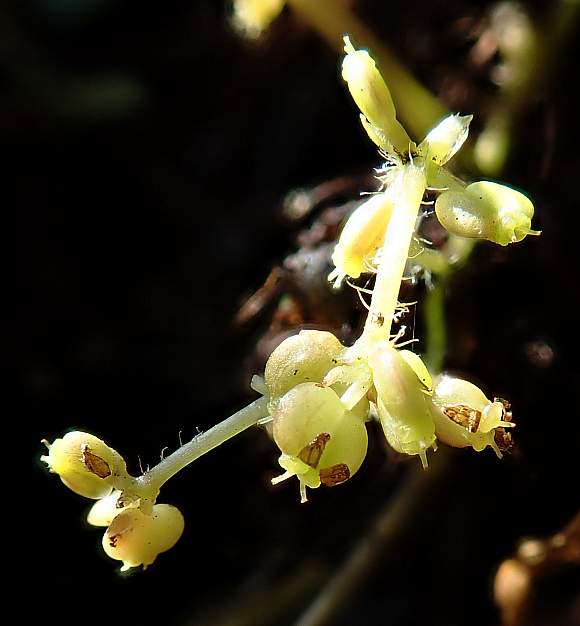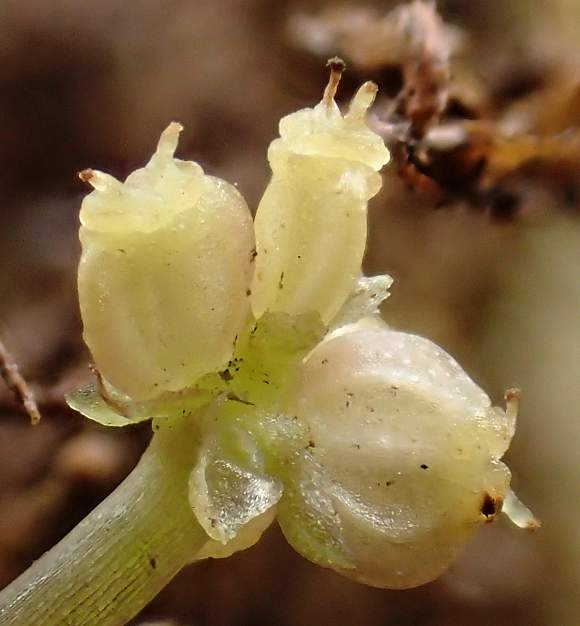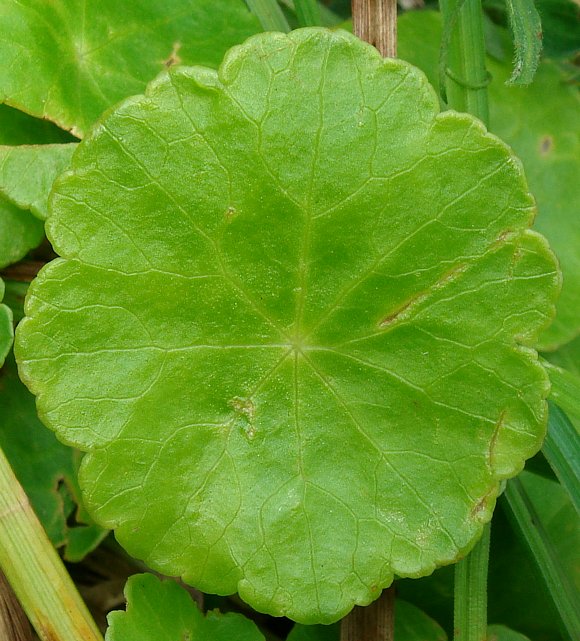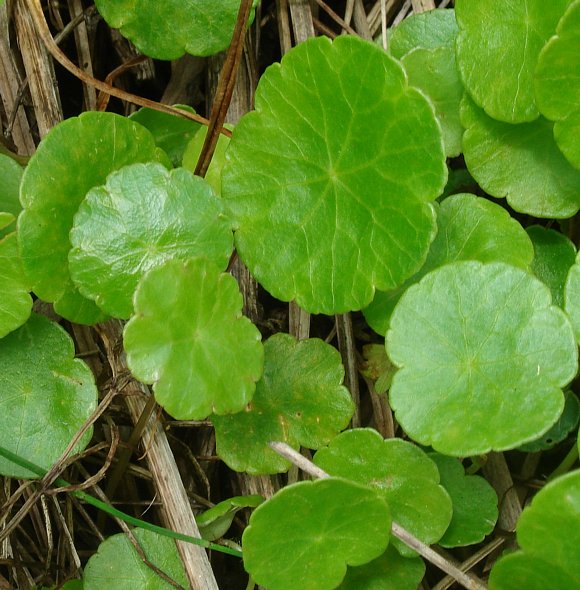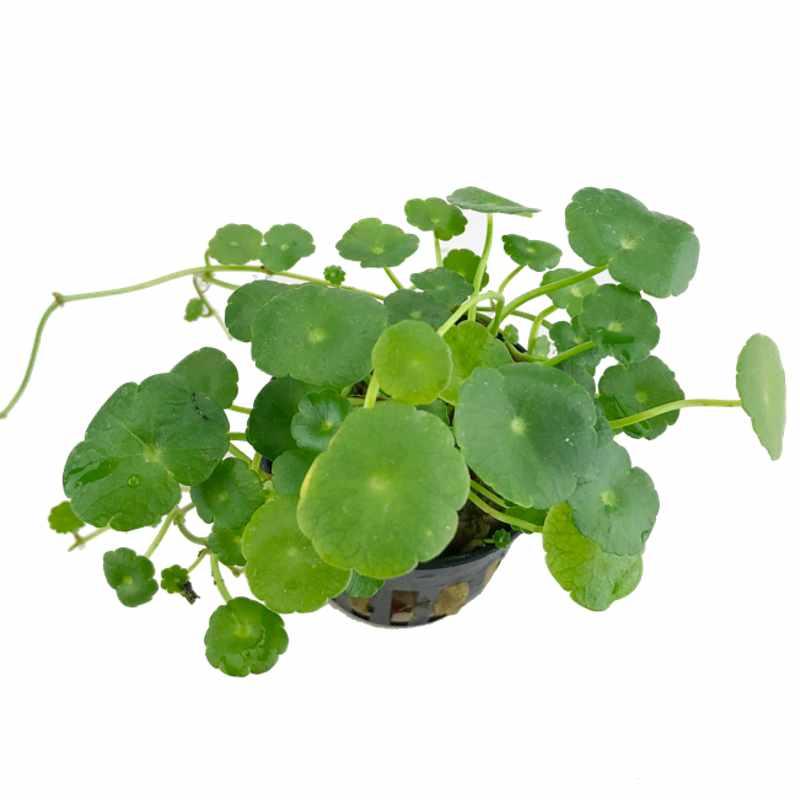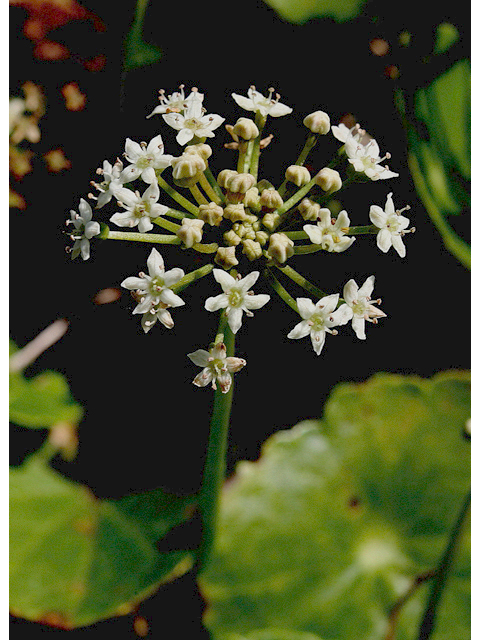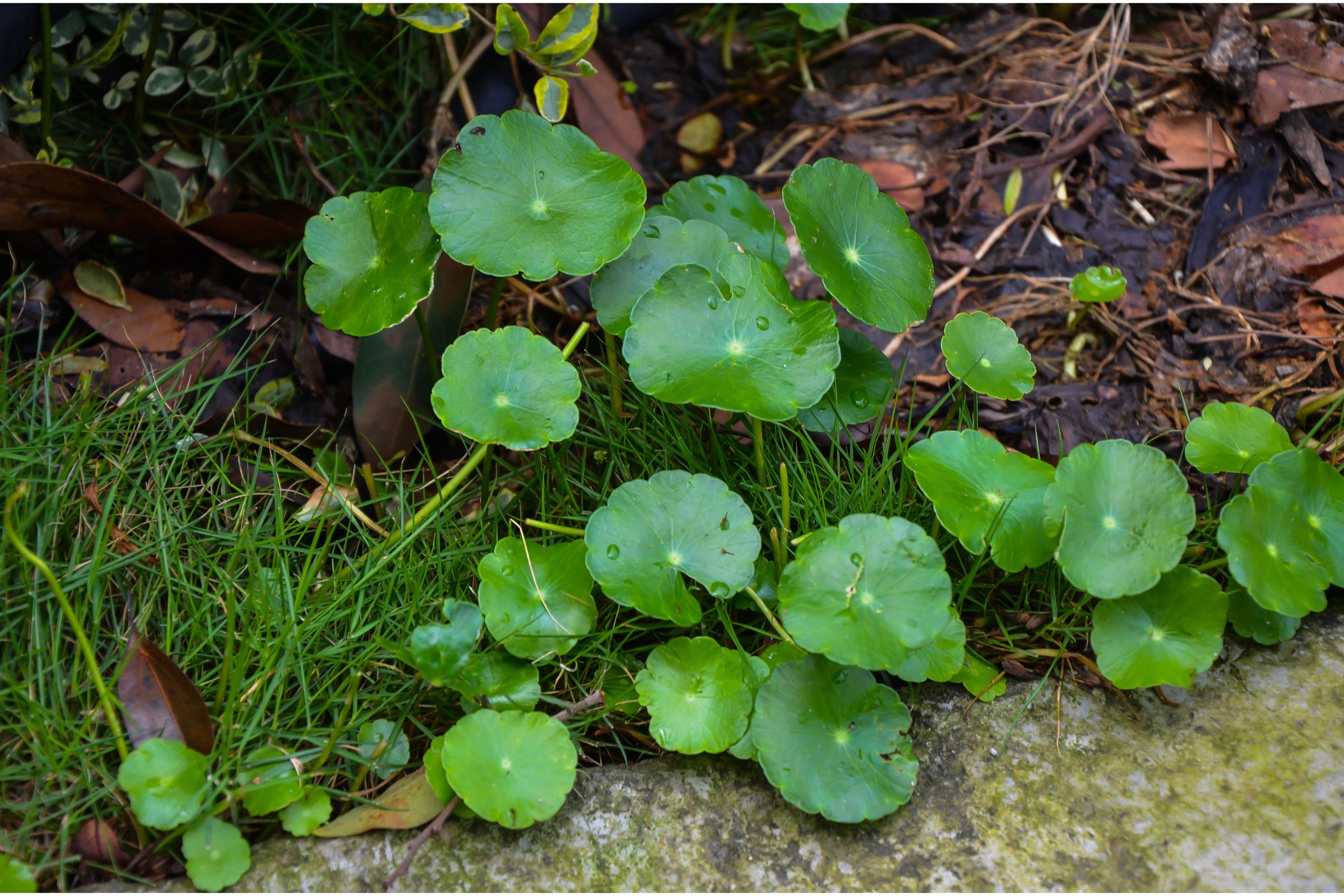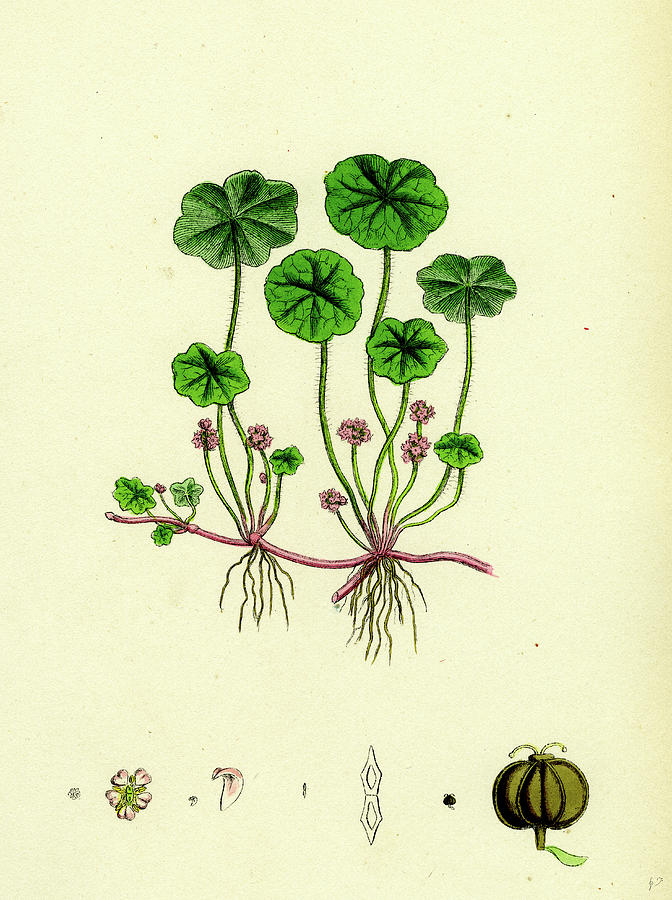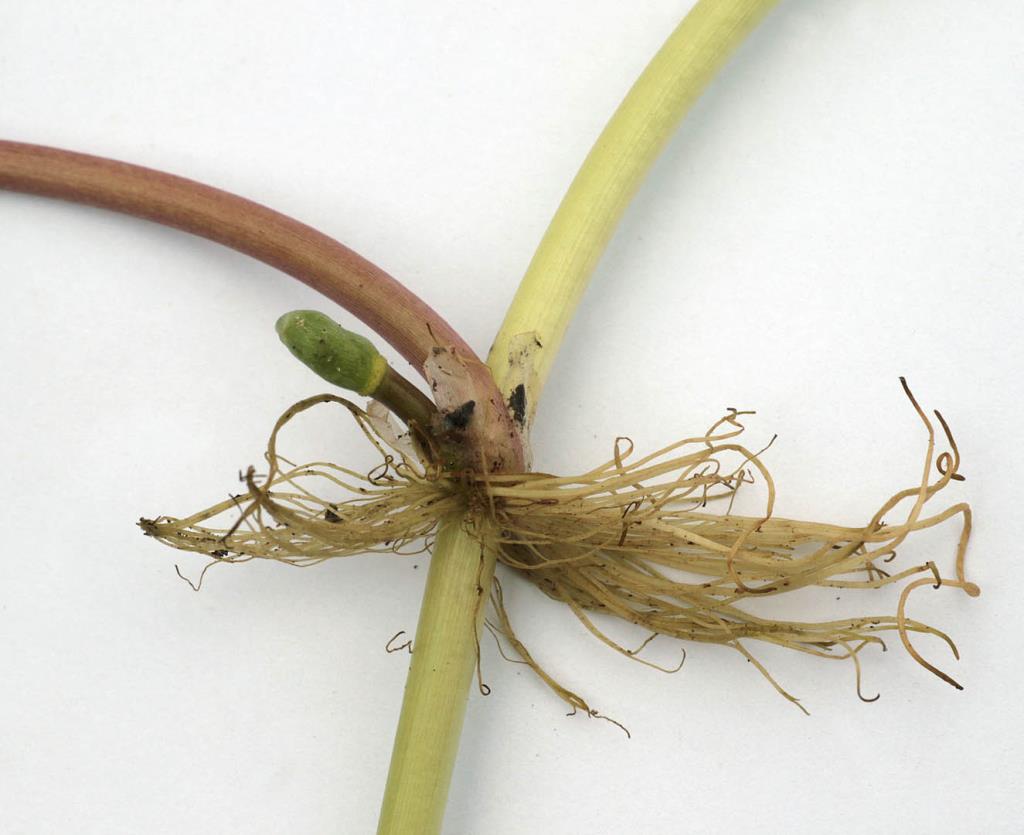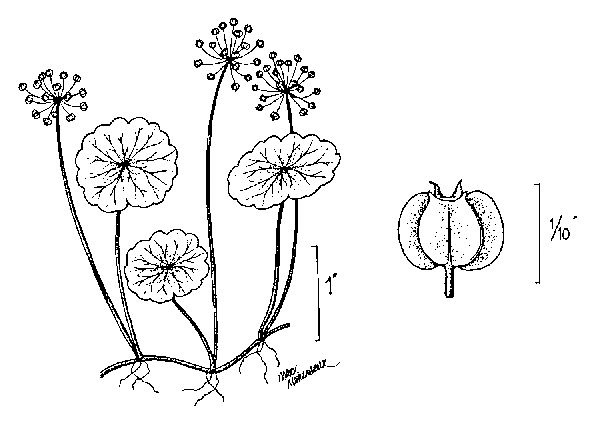| Marsh pennywort Quick Facts | |
|---|---|
| Name: | Marsh pennywort |
| Scientific Name: | Hydrocotyle umbellata |
| Origin | South America throughout central America and the Caribbean and along the Atlantic coast, Chile and Paraguay |
| Colors | Initially green may turn brown or tan in color as they mature |
| Shapes | Schizocarp, which is a type of dry fruit that splits into separate, one-seeded segments upon maturity |
| Taste | Mildly tangy, slightly bitter, and herbaceous |
| Health benefits | Wound healing, Stress and anxiety relief, Skin health, Digestive health, Liver support, Cardiovascular health, Anti-aging effects, Respiratory health, Weight management, Eye health, Bone health, Blood sugar regulation, Kidney health |
| Name | Marsh pennywort |
|---|---|
| Scientific Name | Hydrocotyle umbellata |
| Native | Occurs from south America throughout central America and the Caribbean and along the Atlantic coast, Chile and Paraguay |
| Common Names | Marsh pennywort, Water pennywort, Water navelwort, Marsh penny, Water penny, Indian pennywort, Dollarweed, Water penny grass, Pennyweed, Navelwort, Marshmallow weed, Marsh pennywort herb, Water pennywort herb, Pennywort herb |
| Name in Other Languages | Afrikaans: Waternavelkruid Albanian: Lulegjate uji Arabic: Qartam Mustanaqi (قرطم مستنقعي) Armenian: Jrahosank (Ջրահոսանք) Azerbaijani: Su erişi Basque: Urezko burukoil Belarusian: Vadziany kostsyushak (Вадзяны косцюшак) Bengali: Thulshi Pata (থুলসি পাতা) Bicolano: Manu-mani Breton: Kentelenn diorrenk Bulgarian: Voden buzdjak (Воден буздяк), Vodna marulya (Водна маруля) Burmese: Lei Yat Soak (လေးရက်သောက်) Catalan: Centella asiàtica Cebuano: Kulasimani Chewa: Litsinjo la madzi Chichewa: Mtedza wamudzi Chinese: Sǎn xíng tiān hú suī (伞形天胡荽) Cornish: Gwyrin ughel Croatian: Vodeni pupak, Vodeni noćurak Czech: Vodníchochol, Vodník kadeřavý Danish: Vandnavleurt Dutch: Wateraardbei English: Manyflower Marshpennywort, Water Pennywort, Many-Flowered Marsh Pennywort, Many-flowered water-pennywort, Marsh Pennywort, Many-flowered marsh-pennywort Estonian: Vee-umbrohi, Veekübar Faroese: Vatnablað Filipino: Kulasiman Finnish: Vesinapa French: Gotu kola, Hydrocotyle à ombelle Galician: Centella asiática Georgian: Tsqaros mertsquli (წყაროს მერწყული) German: Wassernabel, doldiger Wassernabel Greek: Hydrokotýli (Υδροκοτύλη) Guadeloupean Creole: Zeb dlo Haitian Creole: Pye dlo Hawaiian: Hāwanawana wai Hausa: Kashi da ruwa, Naman madara Hebrew: Satek Yam (סטק ים) Hiligaynon: Tanglad Hindi: Brahmi (ब्राह्मी) Hungarian: Vizes turbolya Icelandic: Vatnagræna Igbo: Ihe mmiri Ilocano: Talinum Indonesian: Pegagan Air, Antanan Irish: Feithleog Uisce Italian: Centella Asiatica Jamaican Patois: Wata bela Javanese: Pegagan Kannada: Ondugre (ಒಂದುಗ್ರೆ) Kazakh: Su dybyl (Су дыбыл) Kriolu: Pot d’águ Kyrgyz: Suu doby (Суу добы) Latvian: Ūdens naba Lithuanian: Vandens amžinas Macedonian: Vodeno ushte (Водено уште) Malay: Daun Dewa Air, Pegaga Malayalam: Vallarinte Ila (വല്ലരിന്റെ ഇല) Manx: Lus ny ushtey Maori: Whakatū Marathi: Ghodalepan (घोडळेपान) Maltese: Centella Asiatica Ndebele: Iqhude elamanzi Ndyuka: Watra wortu Nepali: Jalbilo (जलबिलो) Norwegian: Vannnavleurt Papiamento: Yerba di awa Polish: Wąkrotka wodna Portuguese: Centella Asiática, chapeus, acaricoba Punjabi: Brahmi (ਬ੍ਰਾਹਮੀ) Romanian: Răchitană de apă Russian: Vodyanoi shelkovitsy (Водяной шелковицы) Samoan: Fofo’anga vai Saramaccan: Watrabladu Scottish Gaelic: Lus bhothan uisge Serbian: Vodeni pupak (Водени пупак), Vodeni lisnjak (Водени лисњак) Sesotho: Moroho wa metsi Setswana: Sekele Shona: Mutamba wezvipo Sindhi: Ranani Ji Bako (رانڻي جي بڪو) Sinhala: Malu Pahal (මලු පහළ), Wallara (වල්ලාරා) Slovak: Vodný kosť, Vodný kosatec Slovenian: Vodna broška, Vodni šentjanževka Somali: Xijaabaha biyo Spanish: Centella Asiática, Yerba de cuatro, paraquita, redondita de agua, sombrilla japonesa, berro macho, sombrerito de agua Sranan Tongo: Watra nabel Sundanese: Antanan Swahili: Mtaalamu wa Maji, Kunde la maji Swazi: Lihlambela lemanzi Swedish: Vattennavleört, Vattennavel Tajik: Daraxtaki obi ab (Дарахтаки оби аб) Tamil: Vallarai (வல்லாரை) Tausug: Buan-buan Telugu: Vallari Aaku (వల్లారి ఆకు) Thai: Ton Bua Bok (ต้นบัวบก), Waen kaeo (แว่นแก้ว ) Turkish: Su Böğürtleni Turkmen: Suw buwulany Ukrainian: Vodyanyy krutoplit (Водяний крутопліт), Vodyanyy shovkovytsi (Водяний шовковиці) Urdu: Brahmi (براہمی) Uzbek: Suv boboyi Vietnamese: Rau má Waray: Takip-suso Welsh: Pentamla dwr Xhosa: Ixhoba Yoruba: Irawo ile, Akwụkwọ na mmiri Zulu: Uhlambela wamanzi |
| Plant Growth Habit | Low growing, aquatic or subaquatic, floating or creeping, slightly succulent herbaceous perennial plant |
| Growing Climates | Found growing in swamps, floodplains, levees, shallow water of pond pine flats, shallow water of flowing streams, drainage ditches, moist sands of open flat woods, lake shores, rice field margins, moist roadside ditches, humid coastal savannahs, manmade ponds, wet pastures, sandy peaty ditches, marshes, wetlands, edges of ponds or streams and hydrophilic grasslands |
| Soil | Marsh pennywort prefers soil that is rich in organic matter and retains moisture well. It can adapt to different soil types, including clay, loam, or sandy soils, as long as they have good moisture retention properties. The soil should be consistently moist without becoming waterlogged |
| Plant Size | About 10 to 20 centimeters (4 to 8 inches) |
| Root | Possesses a fibrous root system, which means it has a network of fine, thread-like roots rather than a single taproot |
| Stem | Stem typically grows horizontally along the ground or just below the water surface. This creeping or prostrate growth habit allows the plant to spread and colonize wetland habitats effectively |
| Bark | Does not have traditional bark like woody plants |
| Leaf | Leaves of Marsh pennywort are circular to kidney-shaped and have smooth margins. They are typically small, measuring around 2 to 5 centimeters (0.8 to 2 inches) in diameter. The leaves are held on long petioles, which attach them to the stems |
| Flower | Small, inconspicuous flowers that are usually white or pale green in color. These flowers are clustered together in umbels, which are groups of flowers that radiate from a central point |
| Fruit Shape & Size | Schizocarp, which is a type of dry fruit that splits into separate, one-seeded segments upon maturity |
| Fruit Color | Initially green may turn brown or tan in color as they mature |
| Seed | Small, rounded to oval shape and are typically around 1-2 millimeters in diameter |
| Flavor/Aroma | Mild, earthy scent with hints of freshness |
| Taste | Mildly tangy, slightly bitter, and herbaceous |
| Plant Parts Used | Leaves, stem, Extracts and Tinctures |
| Propagation | By seeds, division, Stem Cuttings |
| Varieties |
|
| Season | July to October |
| Major Nutrition |
|
|
|
| Available Forms |
|
Plant Description
Marsh pennywort is a low-growing, aquatic or subaquatic, floating or creeping, succulent herbaceous perennial with stems known as stolon. The plant creates dense mats or clumps that can spread horizontally across the surface of the soil or water. The stems are typically between 10 and 20 centimeters (4 to 8 inches) long and slender. The plant is found growing in swamps, floodplains, levees, shallow water of pond pine flats, shallow water of flowing streams, drainage ditches, moist sands of open flat woods, lake shores, rice field margins, moist roadside ditches, humid coastal savannahs, manmade ponds, wet pastures, sandy peaty ditches, marshes, wetlands, edges of ponds or streams and hydrophilic grasslands. It prefers organically-dense, well-moisturized soil. It can acclimatize to a variety of soil types, including clay, loam, and sandy soils, as long as they retain moisture well. The soil should maintain a consistent level of moisture without becoming saturated.
Appropriate growing environment of Marsh pennywort
Marsh pennywort thrives in specific growing environments that provide the necessary conditions for its optimal growth. Here are the key elements of an appropriate growing environment for Marsh pennywort:
- Moisture: Marsh pennywort requires conditions that are consistently damp to wet. It thrives in wetlands, marshes, boggy regions, and areas with high water tables. The plant prefers a constant water source, so it is frequently found near ponds, streams, and other bodies of water.
- Sunlight: While it can tolerate some shade, Marsh pennywort generally prefers partial to full sunlight. It flourishes in areas that receive several hours of direct sunlight per day. In regions of extreme heat, partial shade can protect against excessive solar exposure.
- Soil: Marsh pennywort prefers soils that are abundant in organic matter and retain water effectively. It can thrive in a variety of soils, including clay, loam, and sand, as long as they remain consistently moist. To prevent waterlogging, the soil must have adequate drainage, but it must also retain enough moisture to keep the plant hydrated.
- PH Level: Typically, marsh pennywort favors mildly acidic to neutral soil conditions. Generally, a pH range of 5.5 to 7.5 is optimal for its growth. The pH level of the soil can be tested to determine if any modifications are required to create an optimal growing environment.
- Temperature: Marsh pennywort is adaptable to a variety of temperature ranges, but prefers milder environments. It is more prevalent in tropical and subtropical regions where temperatures are moderate to warm year-round. However, it can withstand frigid temperatures if given adequate protection.
- Water quality: Marsh pennywort is susceptible to changes in water quality. It flourishes in clean, unpolluted bodies of water. Avoid sowing it in areas where the water is contaminated or where there is excessive chemical runoff.
Roots
Instead of a singular taproot, marsh pennywort has a fibrous root system consisting of a network of fine, thread-like roots. This form of root system enables the plant to extract water and nutrients efficiently from the surrounding soil. Adventitious roots are those that develop from non-root plant organs, such as stems or foliage. These roots grow downward into the water or substrate from the lower terminals of the stem. Rhizomes, which are underground horizontal stems, are also present. Rhizomes serve as both a means of vegetative reproduction and nutrient storage organs. They produce new shoots and roots, contributing to the plant’s ability to proliferate and colonize wetland habitats.
Numerous fine root filaments cover the roots of the plant. These root hairs increase the surface area of the roots, thereby enhancing their capacity to assimilate water and minerals from their surroundings. The roots of marsh pennywort absorb water and dissolved nutrients, such as nitrogen, phosphorus, and potassium, from the aquatic or marshy substrate. These nutrients are essential to the growth and development of the organism.
Stem
Typically, stems grow horizontally along the ground or just beneath the surface of the water. This prostrate or creeping growth habit enables the plant to effectively spread and colonize wetland habitats. The stem is herbaceous, indicating it lacks the hard, lignified tissues characteristic of woody stems. It is also succulent, which enables the plant to acclimatize to its aquatic or marshy environment by retaining water.
The stem is composed of both nodes and internodes. Leaves, adventitious roots, and other plant organs emerge from nodes on the stem. In contrast, internodes are the spaces between nodes. It may produce stolon, which are specialized horizontal stems that grow above or just below the earth surface. Stolon enables vegetative propagation by producing new roots and shoots at multiple sites along their length.
Bark
Marsh pennywort lacks the traditional bark characteristic of woody plants. Instead, it has an herbaceous stem, which lacks the protective, brittle outer layer of trees and shrubs. Herbaceous plants, such as Marsh pennywort, typically have delicate, green stems that lack true bark. In wetland environments, they rely on alternative structural adaptations for growth and survival.
Leaves
Typically, leaves are round or kidney-shaped, approximating miniature umbrellas. They have a smooth, relatively flat surface and a diameter ranging from a few centimeters to a few inches. The leaves have conspicuous veins that radiate outward from the base. These veins support the leaf’s metabolic processes by transporting water, nutrients, and carbohydrates throughout the leaf. The leaf margins may be either smooth or slightly serrated (consisting of small, irregular teeth). This variation in the leaf margin is a distinguishing feature of Marsh pennywort and can differ among individual plants. Typically, the leaves are arranged alternately along the stem. This indicates that each leaf emerges from a distinct point on the stem, as opposed to directly opposite one another.
The leaves are supported by petioles, which are slender leafstalks. These petioles are responsible for attaching the leaves to the stem and positioning them optimally for light absorption during photosynthesis. The texture of the leaves is smooth and mildly succulent. This trait assists the plant in retaining water and adapting to its aquatic or marshy environment. Depending on environmental conditions, the color of the foliage may vary. Typically, the foliage is a brilliant shade of green, which indicates a healthy chlorophyll content and effective photosynthesis.
Flower
Flowers are arranged in a cluster known as an umbel. Multiple flower stalks, called pedicels, radiate from a central point at the apex of the stem to form an umbel. Typically, the diameter of the blooms is only a few millimeters. They are typically delicate pink or white, though variations are possible. Each Marsh pennywort flower is composed of the following parts: The calyx is the flower’s outermost whorl. It is composed of five small, green sepals that enclose and protect the blossom as it develops.
The corolla is the whorl within the calyx, and it consists of five small structures that resemble petals. These petals, which are typically translucent or pale pink, serve to attract pollinators. The corolla of a flower contains multiple filaments. Stamens are the male reproductive organs of the flower, consisting of a filament and pollen-producing anthers. There is a solitary pistil, which is the female reproductive organ, in the center of the flower. The pistil consists of the stigma, the style, and the ovary. The stigma is the adhesive, receptive surface where fertilizing pollen is deposited. This canal connects the stigma to the ovary, which contains the ovules. Flowers are pollinated predominantly by insects, such as bees and butterflies, attracted to their nectar and vibrant colors. They may emanate a light, pleasant scent that helps attract pollinators.
Fruits
Fruit is a schizocarp, which is a type of dry fruit that splits into pieces with only one seed when it is fully grown. The fruits are small and round or oval in shape most of the time. Most of the time, they are less than 1 centimeter across. The fruits are green when they are young, but as they age, they may turn brown or tan. The developed fruit has two different parts, called mericarps. Each mericarps has a single seed inside, which is held in place by the flower’s continuous style.
Seeds
The seeds are small and either round or oval. Most of the time, they are between 1 and 2 millimeters in width. Most of the time, the seeds are brown or dark brown, but the exact color can change based on how old the seed is. The seed coat or testa is the outside layer of the seed. It is thin, smooth, and kind of see-through. The embryo and endosperm inside the seed are protected by the seed coat. Endosperm is a part of the seed that is full of nutrients. During the process of germination, the endosperm feeds the growing embryo. The embryo is the young plant that is still growing inside the seed. The embryo in Marsh pennywort seeds is small and is found in the endosperm. It is made up of the cotyledons, the stem, and the root.
Varieties of Marsh pennywort
There are several varieties or subspecies of Marsh pennywort that have been identified. Here are a few notable varieties:
- Hydrocotyle umbellata var. umbellata: This is the standard type of Marsh pennywort, which grows in many places and is often found in wetlands. It has groups of small, round leaves on long stalks that look like an umbrella.
- Hydrocotyle umbellata var. pentapetala: This type is known for having flowers with five petals. The small, white flowers are grouped in umbels on long stalks.
- Hydrocotyle umbellata var. chapmanii: This type is mostly found in the southeast of the United States. It has smaller leaves than most varieties, and the tips of the leaves may have small teeth or lobes.
- Hydrocotyle umbellata var. palmata: This type is known for its deeply split leaves that look like hands. Some parts of North America have it.
Health benefits of Marsh pennywort
Marsh pennywort is a plant that belongs to the Apiaceae family and is known for its various health benefits. Here are some of the potential health benefits of Marsh pennywort:
1. Antioxidant properties
Marsh pennywort has a lot of antioxidants, which help protect the body from the damage that free radicals can do to cells. Antioxidants can lower the risk of long-term diseases like heart disease and some types of cancer by getting rid of these dangerous molecules.
2. Anti-inflammatory effects
There are chemicals in the plant that help reduce inflammation. Inflammation is linked to a number of health problems, such as arthritis, inflammatory bowel disease, and skin disorders. These compounds can help lower inflammation in the body.
3. Wound healing
Marsh pennywort has been used directly for a long time to help wounds heal. It is thought to help tissues heal, reduce inflammation, and cause new skin cells to grow. It may also help keep cuts from getting infected because it kills bacteria.
4. Cognitive function
Marsh pennywort has been looked at for how it might affect the brain. Some research shows that it may help people remember things better and think more clearly. The plant’s ability to help keep the brain healthy and improve blood flow to the brain is thought to be behind these benefits.
5. Stress and anxiety relief
Marsh pennywort is thought to be an adaptogen, which is a substance that helps the body deal with stress and makes people feel more relaxed. By adjusting the body’s stress response system, it may help lower anxiety and ease the symptoms of conditions that are caused by stress.
6. Skin health
People know that the plant is good for the face. It is thought to make the skin more flexible, lessen the look of wrinkles, and give the skin a healthy glow. Marsh pennywort extracts are often found in skin care items because they moisturize and calm.
7. Digestive health
Marsh pennywort has long been used to help keep the digestive system healthy. It may help heal stomach ulcers, improve digestion, and relieve bloating and heartburn. It may also have a slight laxative effect, making bowel movements more regular.
8. Liver support
Some studies show that Marsh pennywort may be hepato-protective, which means that it helps keep the liver healthy and keeps it from getting hurt. It might help the liver work better, speed up the detoxification process, and lower the risk of getting liver illnesses.
9. Cardiovascular health
Marsh pennywort may help keep your heart healthy by improving blood flow, lowering inflammation in your blood vessels, and keeping your cholesterol levels at a healthy level. These things can help keep your heart healthy and lower your chance of heart diseases.
10. Anti-anxiety and mood support
Marsh pennywort has been used as a natural treatment for anxiety and mood problems in traditional medicine. It is thought to have a calming effect on the nervous system, making people feel more relaxed and lowering anxiety. Some studies have shown that it may have anti-anxiety effects, which makes it a possible alternative way to deal with worry.
11. Diuretic properties
Marsh pennywort is a diuretic, which means it can make you pee more and help your body get rid of extra fluids. This diuretic effect may help people with edema (too much fluid in the body) or urinary tract infections get rid of toxins and lower swelling.
12. Anti-aging effects
Marsh pennywort has antioxidants, which may help keep people from getting old. By getting rid of free radicals and lowering oxidative stress, these substances can help keep cells from getting damaged and aging too quickly. Marsh pennywort can help you look younger if you eat it or put it on your skin on a regular basis.
13. Respiratory health
Marsh pennywort has been used for a long time to help keep the lungs healthy. It is thought to have properties that help loosen and get rid of mucus in the respiratory system. People with breathing problems like asthma, coughing, or coughs may benefit from this.
14. Weight management
Some research shows that Marsh pennywort may be able to help people lose weight. It is thought to help speed up the metabolism and burn more fat, as well as curb hunger and cravings. But more research needs to be done to fully understand how it helps people lose weight.
15. Anti-allergic properties
Marsh pennywort has been used to treat allergies in traditional medicine. By changing the immune response, it may help lessen allergic reactions like itching, redness, and swelling. This makes it a possible natural treatment for allergies and skin problems caused by allergies.
16. Eye health
Marsh pennywort has chemicals in it that may help keep the eyes healthy. It may help protect the eyes from damage caused by oxidative stress and inflammation because it has antioxidant and anti-inflammatory properties. Consuming on a regular basis may help keep your eyes healthy.
17. Bone health
Some studies show that Marsh pennywort might be good for your bones. It could help increase the mineral density of bones and lower the chance of osteoporosis. This could be because it might help the body absorb calcium and change the way bones are made.
18. Immune system support
Marsh pennywort is full of vitamins, minerals, and antioxidants that can help the nervous system. By giving you important nutrients and protecting you from oxidative stress, it may help boost your immune system and lower your risk of getting sick.
19. Anti-cancer properties
In lab tests, chemicals in marsh pennywort have shown that they might be able to fight cancer. These chemicals may help stop cancer cells from growing, stop new blood vessels from forming that help tumors grow (this is called “anti-angiogenesis”), and cause cancer cells to die (this is called “apoptosis”) in the body. But more research is needed to find out how well it works in human tests and if it could be used as a therapy along with standard cancer treatments.
20. Blood sugar regulation
Some research shows that Marsh pennywort might help keep blood sugar levels in a healthy range. It may help control how glucose is used in the body, make insulin work better, and lower the chance of insulin resistance and type 2 diabetes. But more research needs to be done to confirm these benefits and figure out the best dose and length of use.
21. Anti-microbial properties
Marsh pennywort has been used for a long time to kill germs. It might be able to kill bacteria, viruses, and fungus, which could stop their growth and stop infections. Because of this, it could be a natural cure for diseases caused by microbes.
22. Kidney health
Marsh pennywort is thought to make you pee more, which is good for your kidneys. By making more urine and flushing out toxins, it may help keep the kidneys working well and lower the risk of getting kidney stones or an infection in the urinary system. But people who already have problems with their kidneys should talk to a doctor before using Marsh pennywort.
23. Anti-venom properties
Some tests have shown that Marsh pennywort might be able to stop the effects of poison. It might help lessen the effects of some snake venoms by stopping the enzymes in the venom and making it less toxic. This shows that it might be a good natural way to treat snakebites. But more study is needed to fully understand how well it works and how safe it is in this way.
24. Anti-ulcer activity
Marsh pennywort has been used for a long time to help keep the digestive system healthy and heal stomach ulcers. It might help stop the stomach from making too much acid, protect the stomach lining, and help healthy cells grow back. But if you think you have an ulcer or have been told you do, it’s important to talk to a doctor because you need the right care.
25. Anti-arthritic effects
Marsh pennywort has been looked at to see if it might help with arthritis. It may help people with arthritis reduce joint stiffness, ease pain, and move their joints better. But more study is needed to confirm that it works and is safe for treating arthritis.
Culinary uses of Marsh pennywort
Marsh pennywort has been utilized as a food source in certain cultures. Here are some details about the culinary uses of Marsh pennywort:
- Raw Consumption: In some places, young Marsh pennywort leaves and roots are eaten raw. They add a fresh, crisp taste to salads and can also be used as a garnish. The leaves taste gentle and a little bit sour.
- Cooking: Marsh pennywort can also be cooked and used in many different ways. You can boil, stir-fry, or steam the leaves and stems. They are a healthy green food that can be added to soups, stews, or vegetable dishes. Cooking Marsh pennywort can make it less bitter and lighten its texture.
- Herbal Tea: The leaves of marsh pennywort can be used to make tea. The flavor and health benefits of the leaves are extracted by putting them in hot water. People often drink tea because it tastes good and may be good for their health.
- Salads and Garnishes: Marsh pennywort leaves can be used as a garnish or added fresh to a salad. They have a crisp texture and a slightly sour taste that makes meals more interesting.
- Stir-Fries and Sautéed Dishes: You can make a healthy food out of the young shoots and leaves of marsh pennywort by stir-frying or sautéing them. Put some oil in a pan and heat it up. Add the marsh pennywort and cook it for a few minutes, until it wilts. Add your favorite herbs and spices to make it taste better.
- Herbal Infusions and Teas: You can use marsh pennywort to make plant teas and infusions. You can make a soothing tea by boiling a handful of fresh marsh pennywort leaves in water for a few minutes, then straining the liquid. If you want to improve the taste, you can add honey or lemon.
- Soups and Stews: Marsh pennywort can be used to give soups and stews a unique flavor and make them healthier. Just cut the leaves and stems into small pieces and add them to your favorite soup or stew while it’s cooking.
- Wraps and Rolls: Marsh pennywort has big, round leaves that can be used to wrap up different foods. They can be put in boiling water for a short time to soften them so they can be used to wrap rice, veggies, or meats. The leaves give the dish a mild, herb-like taste.
- Juices and Smoothies: The leaves of marsh pennywort can be mixed with fruits, veggies, or other herbs to make juices and smoothies that are good for you. The fresh leaves give the drink a green, earthy note that goes well with the other tastes.
- Pesto and Sauces: Marsh pennywort can be added to pesto, sauces for pasta, sandwiches, or dips, or it can be eaten on its own. In a food processor, mix together fresh marsh pennywort leaves, garlic, nuts (like pine nuts or walnuts), olive oil, and Parmesan cheese. You can blend it until it’s smooth and then use it as a tasty sauce.
- Herb Butter: When chopped finely and mixed with melted butter, marsh pennywort makes tasty herb butter. You can put this herb-flavored butter on bread, steamed veggies, grilled meats or seafood to make them taste better.
- Rice Dishes: You can add fresh and fragrant marsh pennywort leaves to rice recipes like pilaf or biryani by chopping them up. The leaves can be cooked with the rice or added as a garnish right before serving.
- Spring Rolls: Marsh pennywort leaves can be used instead of standard rice paper to wrap spring rolls. Fill them with your pick of vegetables, noodles, and protein, then roll them up and eat them. The leaves give the traditional spring roll a unique twist.
- Omelets and Frittatas: You can add flavor and nutrients to omelets and frittatas by chopping up marsh pennywort leaves and putting them in them. Before cooking, just mix the leaves into the beaten eggs and continue with your favorite omelet or frittata method.
- Dressings and Marinades: Marsh pennywort can be used to add a unique flavor to sauces and marinades. Mix the leaves with other things like olive oil, vinegar, garlic, and spices to make a tangy and herbaceous dressing or marinade for salads, meats, or veggies.
- Herbal Buttermilk or Lassi: You can make healthy herbal buttermilk or lassi by mixing fresh marsh pennywort leaves with yogurt or buttermilk and adding spices like cumin or black salt. In Indian food, this drink is especially famous.
- Herbal Butterscotch Sauce: For a standard butterscotch sauce, simmer marsh pennywort leaves in a mixture of butter, sugar, and cream. Strain out the leaves and use the sauce to top sweets like ice cream, cakes, or pancakes.
- Herbal Ice Cubes: Freeze marsh pennywort leaves in water or plant infusions in ice cube trays. These herbal ice cubes can be used to add a bit of flavor and a nice look to drinks like lemonades or cocktails.
Different uses of Marsh pennywort
Marsh pennywort is a versatile plant that offers various uses beyond culinary applications. Here are different uses of Marsh pennywort in detail.
- Herbal Remedies: Marsh pennywort can be used to make poultices, ointments, or oils that have been mixed with herbs. A poultice made from the leaves can be used to treat skin irritations, bug bites, and small cuts. You can massage with infused oils or use them as a base for making your own skin care items.
- Ornamental Plant: Marsh pennywort can be grown in parks or indoors as an ornamental plant. It grows slowly, has pretty round leaves, and small white flowers that make it a nice addition to landscapes or as a ground cover in damp places. It does well in water gardens, bog gardens, or pots that are put in places with some shade.
- Erosion Control: Marsh pennywort is often used to stop soil erosion along stream banks, pond edges, and other places where soil is likely to wash away because it grows quickly and forms thick mats. Its large root system helps keep the earth stable and stops it from washing away.
- Aquatic Gardens: Marsh pennywort grows well in aquariums, water parks, and other places with water. It can grow in places where there is a lot of water, which makes it a great choice for bringing greenery and a natural touch to water environments.
- Wildlife Habitat: Marsh pennywort gives different animals a place to live and food to eat. Small animals can hide and nest in its thick mats, and pollinators like bees and butterflies are drawn to its flowers. The seeds and leaves may also be eaten by birds and small animals.
- Environmental Restoration: Marsh pennywort is sometimes used in projects to improve water quality, stabilize shorelines, and increase wildlife in wetland areas. By putting this plant back into degraded wetland areas, it can help the health and function of the environment as a whole.
- Educational and Research Purposes: Marsh pennywort can be used for learning reasons, like studying plants or going on nature walks. Because of how it grows and how it has changed to live in wet places, it is an interesting plant to watch and learn about.
- Livestock Forage: Marsh pennywort can be used as feed for animals, especially in places where it grows naturally in large amounts. Animals like cows, sheep, and goats can graze on it, which gives them a healthy way to eat. But it’s very important to make sure that the Marsh pennywort species in question is safe and good for animals to eat.
- Traditional Crafts: Marsh pennywort has been used to make crafts in some countries for a long time. The plant’s flexible stems can be woven or braided to make baskets, mats, and small things for decoration. You can also dry the leaves and twigs and use them in flower arrangements or wreaths.
- Herbal Baths: Marsh pennywort can be added to herbal baths to help you relax and give your face the nutrients it needs. Boil a handful of fresh Marsh pennywort leaves in water, strain the juice, and then add it to your bathwater. Soaking in this plant mixture can help soothe the skin, improve blood flow, and calm you down.
- Companion Planting: Marsh pennywort can be used in parks and farms as a plant that grows with other plants. It grows in a way that makes it spread out, and its dense leaves can be used as a ground cover to stop weeds from growing and keep the soil wet. It also helps bring in good bugs and can make the garden a more diverse place generally.
- Soil Improvement: Marsh pennywort can improve the quality of the dirt in some situations. Its large root system can help improve the structure of the soil and let more water through. When the plant dies and breaks down, it adds organic matter to the soil, which makes it more fertile.
- Animal Habitat Creation: Marsh pennywort can help create places that are good for wildlife if it is planted in the right kind of marsh. The plant makes thick mats that amphibians, reptiles, and invertebrates use as homes, places to lay eggs, and food sources.
- Bio-filtration: Marsh pennywort can be used in bio-filtration systems to help clean water because it grows well in damp places. Its roots can take in extra nutrients like nitrogen and phosphorus, which are often found in wastewater or runoff. This reduces water pollution and helps aquatic environments stay healthy as a whole.
- Green Roof Planting: Marsh pennywort can be used on green roofs, especially in places where you want to keep water in the soil. It can grow in damp places and spread quickly, which makes it a good plant for green roofs. It adds to the look and ecological function of these installations.
Side effects of Marsh pennywort
While Marsh pennywort is generally considered safe for most people when used appropriately, it’s important to be aware of potential side effects and precautions. Here are some side effects of Marsh pennywort in detail:
- Skin Sensitivity: Some individuals may experience skin irritation or allergic reactions when in contact with Marsh pennywort. This can manifest as redness, itching, rash, or dermatitis. It is advisable to perform a patch test before using Marsh pennywort topically and discontinue use if any adverse skin reactions occur.
- Photosensitivity: Marsh pennywort has chemicals in it that may make you more sensitive to sunshine, which can make you more likely to get sunburn or damage your skin. If you put Marsh pennywort on your skin, you should stay out of the sun as much as possible or use sun protection measures like sunscreen and protective clothes.
- Pregnancy and Breastfeeding: There isn’t a lot of research information about whether or not Marsh pennywort is safe during pregnancy or while breastfeeding. Before using Marsh pennywort products, women who are pregnant or breastfeeding should talk to a doctor or nurse to make sure they are safe for themselves and their kids.
- Drug Interactions: Marsh pennywort may change how well some medicines work or make them more likely to cause side effects if taken with them. Before taking Marsh pennywort, you should talk to a doctor if you are on any medicines, especially diuretics or blood-thinning drugs. This will help you avoid any possible interactions.
- Liver Health: Some types of pennywort plants have occasionally been linked to liver damage when they are used. Marsh pennywort is usually thought to be safe, but you should only use it in small amounts and stop if you have any signs of a liver problem, like jaundice, stomach pain, or dark urine.
- Interactions with Medications: Marsh pennywort may interact with some medications, especially ones that change how blood clots or ones that stop blood from clotting, like warfarin. The vegetable has chemicals in it that thin the blood, so taking it with medicines that do the same thing could make you more likely to bleed. Before using Marsh pennywort, you should talk to a doctor or nurse if you are on any medicines, especially those that affect how your blood clots or stop it from clotting.
- Allergic Reactions: Even though it is rare, Marsh pennywort can cause allergic responses in some people. Allergies can make the skin rash, hives, and itch, grow, or make it hard to breathe. If you have any signs of an allergic response after using Marsh pennywort, you should stop using it and go to the doctor right away.
- Drug Sensitivity: Marsh pennywort may make people more sensitive to some drugs, like those that are broken down by the liver. It could change how the body handles medicines, which could make the drug levels in the blood higher or lower. If you are taking medicines that are broken down by the liver, you should talk to a doctor before using Marsh pennywort to make sure there won’t be any problems.
- Hormonal Effects: It has been found that marsh pennywort has estrogenic properties, which means it may change the amounts of hormones in the body. This can be helpful in some situations, like when women are going through the signs of menopause. However, people with hormone-sensitive conditions like breast cancer, uterine fibroids, or endometriosis may not be able to use it. If you have any hormone-related illnesses, you should be careful and talk to a doctor.
- Stomach Discomfort: Some people who eat or use Marsh pennywort may have gut problems like upset stomach, bloating, or nausea. If you have a weak stomach or a history of stomach problems, it’s best to use Marsh pennywort in moderation and stop using it if it causes stomach problems.
- Photosensitivity: As was already said, Marsh pennywort can make people more sensitive to the sun. This can make you more likely to get sunburn or damage your skin when you’re out in the sun. When Marsh pennywort is used on the skin, it is best to use sunscreen, wear protective clothes, and spend as little time in the sun as possible.
References:
https://www.itis.gov/servlet/SingleRpt/SingleRpt?search_topic=TSN&search_value=29514#null
https://portal.wiktrop.org/species/show/339809
https://indiabiodiversity.org/species/show/225858
http://www.theplantlist.org/tpl/record/kew-2856369
https://gd.eppo.int/taxon/HYDUM
https://en.wikipedia.org/wiki/Hydrocotyle_umbellata
http://www.stuartxchange.org/Pennywort
https://plants.usda.gov/home/plantProfile?symbol=HYUM


